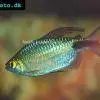African moon tetra - Bathyaethiops caudomaculatus
Scientific name: Bathyaethiops caudomaculatus
Common name: African moon tetra
Family: Alestidae
Usual size in fish tanks: 7 - 9 cm (2.76 - 3.54 inch)
014
Recommended pH range: 6.4 - 7
Recommended water hardness: 5 - 15°N (89.29 - 267.86ppm)
0°C 32°F30°C 86°F
Recommended temperature range: 22 - 26 °C (71.6 - 78.8°F)
The way how these fish reproduce: Spawning
Where the species comes from: Africa
Temperament to its own species: peaceful
Temperament toward other fish species: peaceful
Usual place in the tank: Top levels
Food and Feeding
The African Moon Tetra (Bathyaethiops caudomaculatus) is an omnivore and will readily accept a variety of foods. In captivity, a staple diet of high-quality flake or small pellets is ideal to maintain health and coloration. To provide balanced nutrition, supplement their diet once or twice weekly with protein-rich treats like bloodworms, brine shrimp, or white worms. Live or frozen foods are particularly beneficial for enhancing their natural foraging behavior and overall vitality.
Origin
The African Moon Tetra originates from the Congo River Basin in Central Africa. They are typically found in slow-moving, shaded waterways within the Congo, where they inhabit soft, slightly acidic waters surrounded by dense vegetation. Replicating these conditions in the aquarium helps to keep them comfortable and healthy.
Sexing
Sexing African Moon Tetras is relatively straightforward. Mature females tend to have a rounder and fuller body shape compared to males, especially noticeable as they prepare to spawn. Males are usually slimmer, with a more streamlined appearance.
Breeding
Breeding Bathyaethiops caudomaculatus is possible with proper setup and attention. These tetras prefer to spawn in groups, so include an equal number of males and females in the breeding tank. Adding java moss or spawning mops offers surfaces for egg deposition. Once spawning is complete, promptly remove the parents to prevent egg predation. The eggs typically hatch in a few days, and once the fry become free-swimming, they can be fed infusoria and other fine, nutritious foods suitable for small fry.
Lifespan
With proper care, African Moon Tetras typically live between 3 to 5 years in captivity. Providing stable water parameters, a balanced diet, and maintaining good tank hygiene are key to supporting their longevity.
Tank Requirements
African Moon Tetras thrive in well-planted tanks that mimic their natural habitat. A minimum tank size of 75 liters (20 gallons) is recommended for a small group of six or more, as they are schooling fish and feel most secure in groups. They prefer soft to moderately hard water with a pH of 6.4-7.0 and a temperature range of 22-26°C (71.6-78.8°F). A dark substrate and moderate lighting help to showcase their subtle iridescent coloring, and the addition of leaf litter can provide additional cover and tannins, creating a natural blackwater effect.
Good filtration is essential for this species as they are sensitive to poor water conditions and prone to fungal infections. Performing regular water changes (about 20-25% weekly) is crucial to maintain water quality and ensure a healthy environment.
Suitable Tankmates
The African Moon Tetra is peaceful and compatible with other small, non-aggressive fish. Suitable tankmates include:
- Neon Tetras and Cardinal Tetras
- Harlequin Rasboras
- Corydoras Catfish (various species)
- Otocinclus for algae control
- Small, peaceful dwarf cichlids, such as Apistogramma or German Blue Rams
Avoid large or aggressive fish, as they can stress or intimidate these peaceful tetras.
Recommended Plants
A well-planted tank helps create a comfortable and natural environment for African Moon Tetras. Suitable plants include:
- Java Fern (Microsorum pteropus)
- Anubias (Anubias barteri)
- Amazon Sword (Echinodorus amazonicus)
- Hygrophila (Hygrophila polysperma)
- Java Moss (Vesicularia dubyana)
These plants tolerate low to moderate light and provide shaded areas and cover, which help make the tetras feel secure. Floating plants like Water Sprite can also add shade and reduce light intensity, mimicking their native habitat.
Short Description
The African Moon Tetra (Bathyaethiops caudomaculatus) is a peaceful and visually appealing schooling fish native to the Congo River Basin in Central Africa. Known for its distinct silver body and characteristic black and red spot near the tail, this tetra thrives in well-planted community tanks with stable water parameters. Best kept in groups of six or more, African Moon Tetras are an excellent choice for aquarists looking for a hardy, easygoing addition to their freshwater tank. Regular water changes and good tank maintenance are essential to keep them healthy and prevent fungal infections.
Pictures
Bought by aqua-fish.net from jjphoto.dk.






 Yellowtail
Yellowtail  Red
Red  Longfin
Longfin  Congo
Congo